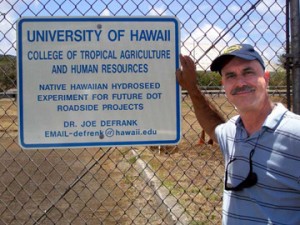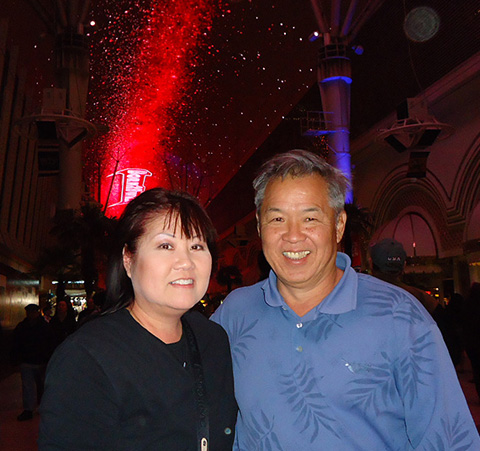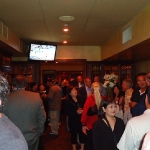Hawaii Golf Course Superintendents Blog
Preliminary Observations on the Traffic Tolerance of Four Seashore Paspalum Cultivars Compared to Hybrid Bermudagrass
SUMMARY. Seashore paspalum (Paspalum vaginatum) is a prostrate, perennial turfgrass used on golf courses and athletic fields in warm-season climates. Research data on the traffic tolerance of seashore paspalum compared with hybrid bermudagrass (Cyndon dactylon · Cynodon transvaalensis) is minimal. A study was conducted in 2008 to evaluate the traffic tolerance of ‘Sea Isle 2000’, ‘Salam’, ‘Sea Dwarf’, and ‘Sea Isle 1’ seashore paspalum relative to ‘Tifway’ hybrid bermudagrass. Traffic was applied with a Cady Traffic Simulator (CTS) and traffic tolerance was assessed visually through measurements of percentage of turfgrass cover after 36, 54, 72, and 90 passes were applied with the CTS. After 90 passes (45 simulated professional football games) with the CTS, ‘Salam’, ‘Sea Dwarf’, and ‘Sea Isle 1’ seashore paspalum exhibited greater traffic tolerance than ‘Tifway’ hybrid bermudagrass; ‘Sea Isle 2000’ seashore paspalum exhibited the least amount of traffic tolerance in this study. These data suggest that some seashore paspalum cultivars may be a suitable alternative to hybrid bermudagrass on athletic fields in warmseason climates.
Dr. Joe DeFrank speaks on the Aiea Baseball field weed cleanup
 In August 2010, Dr. Joe DeFrank in cooperation with Kaipo Bernie and his skilled team of landscape professionals of the Honolulu City and County Parks and Recreation Department, started a weed cleanup of the Aiea baseball field on Oahu, Hawaii. The presentation below contains Dr. DeFrank’s presentation at the Pacific Agriculture Sales and Service Turf seminars and trade show at the Pearl Country Club in Honolulu. The presentation was made on January 20, 2010 and contains a description of all the fertilizer and herbicide applications made over a 4 month period from August to the end of December, 2010.
In August 2010, Dr. Joe DeFrank in cooperation with Kaipo Bernie and his skilled team of landscape professionals of the Honolulu City and County Parks and Recreation Department, started a weed cleanup of the Aiea baseball field on Oahu, Hawaii. The presentation below contains Dr. DeFrank’s presentation at the Pacific Agriculture Sales and Service Turf seminars and trade show at the Pearl Country Club in Honolulu. The presentation was made on January 20, 2010 and contains a description of all the fertilizer and herbicide applications made over a 4 month period from August to the end of December, 2010.
CLICK HERE to play the video clip of the presentation
(runtime: 58 min:10 sec.)
Prior to viewing the video content, the audience should download the seminar handout to better follow the detailed discussion of procedures and results and help incorporate the materials employed and their rates of application into their own operations.
CLICK HERE to download the seminar handout of the presentation
For more information on this presentation contact:
Dr. Joe DeFrank
Professor of Weed Science – University of Hawaii Department of Tropical Plant and Soil Science
email:[email protected].
Efficacy of Sodium Chloride Applications for Control of Goosegrass (Eleusine indica) in Seashore Paspalum Turf
by James T. Brosnan, Joseph DeFrank, Micah S. Woods, and Greg K. Breeden*
Control of goosegrass is difficult in the pan-Pacific region. No herbicides are currently labeled for selective control of goosegrass in seashore paspalum turf, a species used regularly on golf courses throughout the tropics. Sequential granular applications of sodium chloride (99% sodium chloride, 1% sodium silicoaluminate, 83% 0.5 to 0.25 mm diam) at 488 kg/ha did not effectively (. 70%) control goosegrass in this study. Goosegrass injury following sequential granular applications of sodium chloride, at 488 kg/ha, subsided at 6 wk after initial treatment (WAIT). A single application of MSMA at 2.40 kg/ha plus metribuzin at 0.56 kg/ha provided 96 and 83% control of goosegrass 8 WAIT in 2007 and 2008, respectively. Sequential applications of MSMA plus metribuzin at lower rates yielded similar results. Applications of foramsulfuron did not effectively control (. 70%) goosegrass in this study, suggesting a possible tolerance to this treatment. Applications of MSMA plus metribuzin controlled goosegrass (. 70%), but induced phytotoxic injury to seashore paspalum turf. Additional research is needed to evaluate strategies for POST control of goosegrass in seashore paspalum turf that do not induce phytotoxic turfgrass injury after application.
CLICK HERE to view the complete article.
Nomenclature: Metribuzin; MSMA; foramsulfuron; goosegrass, Eleusine indica (L.) Gaertn. ELEIN; seashore paspalum, Paspalum vaginatum Swartz. PASVA.
Greg Norman to Redesign Makaha Valley West Course
New owner, Pacific Links Hawaii, LLC, has also acquired the neighboring East course at the Makaha Valley CC from the developer.
The entity that bought the Makaha Valley West golf course in the Waianae Mountains on the Island of Oahu, Hawaii last year has brought in PGA Tour player Greg Norman to redesign the course, and is also acquiring the neighboring East course at the Makaha Valley Country Club from developer Jeff Stone.
Pacific Links Hawaii, LLC is purchasing the Makaha Valley East course for and undisclosed price, Stone told the Pacific Business News (PBN).
It will be the first time that the two Makaha East and West courses will be under the same ownership since financier Chinn Ho developed Makaha in the 1960s.
“One of my goals was bring them back under one ownership, create a signature golf experience and tie it back to Ko Olina [Resort],” Stone told PBN.
Pacific Links title sponsor of new Hawaii PGA Champions Tour event – Pacific Business News
Pacific Links title sponsor of new Hawaii PGA Champions Tour event – Pacific Business News
Pacific Links Hawaii will serve as the title sponsor for a new event on the PGA’s Champions Tour called the Pacific Links Hawaii Championship that will be played at the Kapolei Golf Course Sept. 10-16, the PGA Tour said Monday.
The 54-hole event will have a $1.8 million purse and feature a field of 81 Champions Tour players, including Greg Norman, who is redesigning the Makaha West Golf Course recently acquired by Pacific Links Hawaii.
“Over the years, Hawaii has served as a mid-point for my commutes between the United States and Australia,” Norman said in a statement. “It is my pleasure to now have a direct involvement in the development of the Pacific Links Hawaii Championship, which will afford me the opportunity to spend more time in Hawaii on a consistent basis.”
Pacific Links Hawaii also owns and operates the Kapolei Golf Course.
Pictures from the GCSAA Golf Show 2012 held in Las Vegas
Wishful Thinking in Vegas as always
From the Convention Center Floor
2012 Photos of the HGCSA Dinner held at Pierro’s Itallian Restaurant in Las Vegas
The HGCSA would like to thank all of the sponsors and people responsible for making this dinner such a wonderful event and experience. We would also like to thank Al Kakazu again for his continued effort in coordinating this event.
Golf Superintendents and families enjoying the attractions of Las Vegas



Class Time!
B. Hayman Co. 12th Annual Field Day & Golf Tournament
COME & SEE WHAT’S NEW!!!
- In-depth Equipment Reviews & Demonstrations
- Give & Receive direct feedback with our manufacturer reps
- Talk story & share info with other turf professionals
- Door prizes will be awarded throughout the day
- Special early bird prizes
- Chance to win $2,500 and other fabulous prizes at our Putting Contest
- A BRAND NEW FLAT SCREEN TV will go to an early bird at the Golf Banquet
- Breakfast, Lunch and Drinks will be served — Check-in early for breakfast
- Registration Forms & More Info to come soon

For more information, please call us – (808) 671-2811 or Toll-free Inter-island (800) 628-9328
Curtis Kono Wins Golf Course Superintendent of the Year for 2011

Curtis graduated from UH with a degree in Horticulture. Curtis started at Honolulu CC in 1977 followed by assignments at Kiahuna in 1982; Poipu Bay in 1989; Kauai Lagoons in 1987 and 1991; Bay View in 1995 and Oahu CC from 1997 to present. Curtis has hosted the PGA Grand Slam @ Poipu, Manoa Cup, OCC Invitational and Hawaii State Amateur Championships at Oahu CC. Curtis has been a volunteer crew member at the Masters, Augusta National, Open Championship at Royal Birkdale and U.S. Open at Shinnecock. Curtis was the Hawaii State Junior Match Play Champion in 1968, Manoa cup Champion in 1987 and multiple winner of the HGCSA Annual Tournament.
Curtis was awarded superintendent of the year for 2011 at the Hoo’lau’lea Golf Awards Banquet. Congratulations to Curtis for a job well done. We are proud of him for his many accomplishments as a fellow superintendent of Hawaii.
This event isn’t a gamble
If you want to win big for your career and facility, attending the 2012 GCSAA Education Conference and the Golf Industry Show is a sure bet.
We know the decision to attend can be a difficult one—until you have all of the facts. That is why we have created the Attendee Justification Kit. This kit offers you the tips, techniques and tools you need to validate your attendance at the 2012 conference and show. Download the kit and discover the resources available to you:
- Tips on reducing your expenses at conference and show
- Advice on sharing your success with your supervisor, facility and community
- A detailed chart that will help you evaluate all of the costs associated with attending
- Testimonials from your peers who continue to find value in attending
- A customizable letter to your supervisor that explains your desire to attend
Weather’s influence on the growth of turfgrasses
by Micah Woods, Ph.D.
[email protected]
www.asianturfgrass.com
Everyone knows that the weather has a huge influence on the growth of turfgrasses, and the weather is one thing that a golf course superintendent cannot control. I have had the opportunity to visit many cities around the world where warm-season grasses are grown, and I am struck by the differences in turfgrass species that thrive in one place and that struggle in another. For example, I have seen kikuyugrass grow well at Lanai and San Diego and at Dalat in the mountains of southern Vietnam, and I know kikuyugrass grows well at many locations in South Africa, but when it is grown at Bangkok kikuyugrass cannot compete with other grasses that grow more aggressively in the Bangkok weather.
The same differences in turf vigor are seen with other warm-season species such as bermudagrass, seashore paspalum, and zoysiagrass. I made this bubble chart to show the average weather data (climatological normals) for different cities around the world, thinking that by looking at the weather data in this way we might be able to get a better understanding of why certain grasses perform better in one area but do not thrive in another.
These data are from the climatological normal tables on the Hong Kong Observatory website and the bubble charts were created using the ggplot2 package in R. If you are interested in seeing these plots on a monthly basis, please go to www.blog.asianturfgrass.com where I have already uploaded the files for May and June average weather and I will be uploading a new bubble chart around the first of each month until April of next year, showing how the average weather for different world cities changes throughout the year on a monthly basis.




















